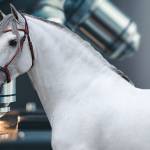Breeding and Competition Careers Not Mutually Exclusive for Stallions

Without question, the dual demands of performance and breeding place stress on stallions. Does this stress mean stallions must do one or the other? A study evaluating stress levels and semen quality suggests dual-use stallions can be successful in both endeavors simultaneously.*
In that study, 18 Warmblood breeding stallions were identified, seven of which were also actively involved in competition. Stress was determined by measuring cortisol levels in saliva. Semen quality was evaluated using standard techniques, including measuring sperm concentration and progressive motility, and using flow cytometry to identify viable sperm. Semen samples were collected from all horses on two occasions one week apart, and saliva samples were collected immediately prior to semen collection.
The saliva cortisol levels were significantly higher in competitive breeding stallions (2.3 ng/mL) compared to stallions used for breeding alone (1.7 ng/mL).
Higher stress levels in the competitive breeding stallions, represented by the higher cortisol levels, were not associated with decreased semen quality in this study.
“Other studies have reported conflicting effects of competition on semen quality. Some studies found sperm concentration and motility are lower in competing stallions compared with noncompeting stallions. One study found that elite-level competition increases sperm count compared with no competition,” shared Ashley Fowler, Ph.D., a nutritionist for Kentucky Equine Research.
The researchers suggested that “appropriate management of competition stallions may compensate for the negative effects on sperm quality…as the stallions in our study are actively managed, high-level sport horses.”
According to Fowler, “proper dietary management can help support the success of competition stallions.” She suggested maintaining an appropriate body condition (body condition score of 5 to 6 on the 9-point Henneke scale) for maximal fertility, and offering the marine-derived long-chain polyunsaturated omega-3 fatty acids docosahexaenoic acid (DHA) and eicosapentaenoic acid (EPA), such as those found in EO-3.
“EO-3 may help improve sperm concentration, motility, and viability, particularly in stallions with subpar sperm quality. These fatty acids become incorporated into the plasma membrane of the sperm cells, which increases the overall quality of semen,” said Fowler.
Changes to sperm characteristics take about 60 days following the start of dietary changes, so it’s important to optimize your feeding program about two months before the breeding season.
*Hensel, B., U. Jakop, M. Schmicke, F. Schroter, M. Jung, and M. Schulze. 2023. Dual use of breeding stallions is possible without affecting the sperm quality. Reproduction in Domestic Animals. doi:10.111/rda.14337.








